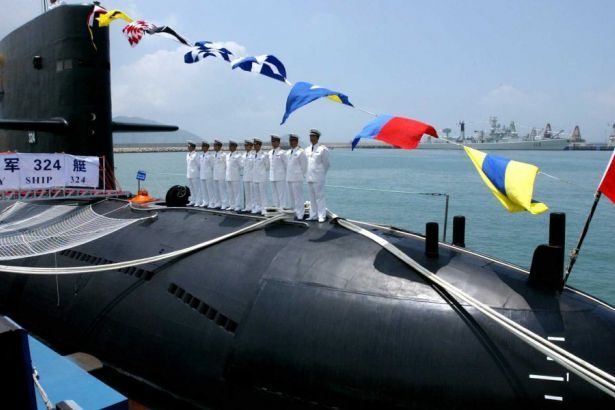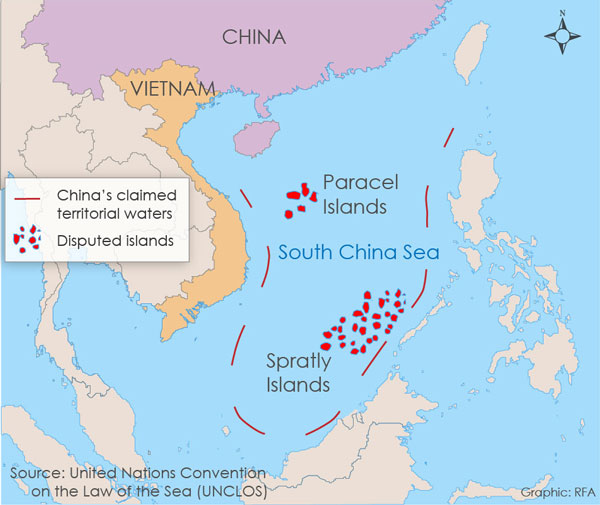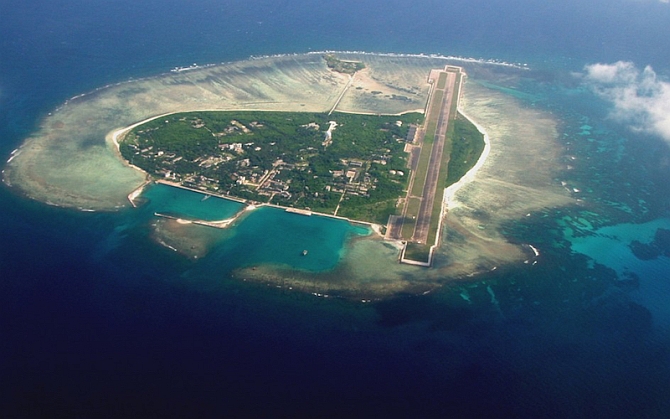Mapping the crisis of imperialism: The placated war in the South China Sea

A long-lasting local problem, the South China Sea dispute, has recently been a bigger matter of discussion and become a global crisis with the US interventions. While China lays claims to the entire sea, Malesia, Brunei, Indonesia, the Philippines and Vietnam also seek their rights in the waters.
The United States, questioning Chinese sovereignty in the region, is heightening the tension by bringing other actors into the scene. Meanwhile, China is trying to defeat the alliance led by the US through diplomacy and economic trumps.
WHY IS THE SOUTH CHINA SEA IMPORTANT?
With China becoming the manufacturing centre of the world, the South China Sea has grown in importance. It has been recently said that the South China Sea, with its trade volume of over $5 trillion per year, is making up the 40% of the global trade and is becoming the main passageway of the trade. The size of the pie is sufficient to describe the importance of the region. The United States, using its volume of trade as a basis, is trying to legitimise its existence in the region. Apart from the economic importance of the region, the South China Sea’s energy sources and who is going to extract them are also continuing to be a matter of debate. It is brought forward that the natural gas reserve in the region will suffice China for decades.
The government of China is also considering the sea as a matter of national sovereignty. The national borders claimed by China, “Nine-Dash Line,” are containing the Paracel and Spratly islands. While the Paracel Islands are in de facto control of China, an important part of the Spratly Islands is controlled by Vietnam, the Philippines, Malesia, Brunei and Taiwan. Treaties signed in the past, different interpretations of them and the “red lines” of the local states are constantly keeping the tension up in the region, where the delicate balance is the base among the states.

China’s “Nine-Dash Line” and the islands
TERRITORIAL RELATIONS AND THE UNITED STATES
Willing to form an anti-China bloc, the US is provoking the regional states through diplomatic channels. The Philippines, an old colony of the US and a close ally afterwards, was one of the countries that the US always relied on. However, the situation dramatically changed as Rodrigo Duterte came into power. Duterte, a supporter of dialogues with China, has announced that he is not supporting the US existence in the region and he will not provide assistance to US ships. The previous Philippine administration had brought the South China Sea case to the UN Permanent Court of Arbitration and won against China, but the decision was repudiated by the Chinese government and lost its importance with the new administration in the Philippines.
Another country, which is having tension with China for a long time, is Vietnam. The Paracel Islands are controlled by China since the Vietnam War. Seizing them from US-backed South Vietnam, China did not give the islands back after the end of the war. Treaties between China and Vietnam signed in the aftermath of the war could only solve a small portion of the disagreement. Vietnam seemed as a candidate for US usage for a while in the region after the developments between Vietnam and the United States. But Chinese President Xi Jinping in a trip to Vietnam in 2015 said he is willing to promote the relations between the to “comrade” countries. Later on, the leaders frequently visited each other. China, the main trade partner of Vietnam, managed to soothe Vietnam largely by proposing treaties. The General Secretary of the Communist Party of Vietnam, Nguyen Phu Trong, who visited China this year, said the disagreements must come to an end, referring to establishing dialogues. In short, the US could not succeed in forging a bloc against China in the region: the moderate messages given to China in the recent ASEAN meeting indicate the point.
THE UNITED STATES AND ITS ALLIES
The US, going towards its off-region allies after failing to establish the bloc, has proposed to form a mutual patrol power in order to “protect the freedom of movement” in the South China Sea. The proposal, made for Japan, Australia and India’s consideration, was not approved by India, yet found favorable by Australia and Japan. The proposal for naval patrols met with China’s reaction. Against the increasing military existence of the US and its allies, China brought nuclear submarines and to the region and expedited the construction of the artificial islands. China, refusing the label “artificial,” for the islands, is claiming that the islands are for civil uses. Setting its naval force strength as the priority because of the South China Sea dispute, China has moved forward by successfully building a domestic aircraft carrier.
On the contrary, US naval groups, which include aircraft carriers as well, have frequently been seen in the region. The tension between the Democratic People’s Republic of Korea and the United States has become a justification tool for the US military existence. Japan’s Shinzo Abe administration’s move away from pacifism and its increasing applications for armament became one of the reasons for the augmenting tension. Eventually, it is not surprising that the South China Sea is considered as the first place for World War III to break out and that top names close to President Trump say it is “certain” to go to war there. The US administration is starting to put the ‘option of war’ into words as it fails to succeed in diplomacy.

An “artificial island” used for flights by China
PLACATING AND WAR PREPARATIONS
A possible war in a region that has a trading volume of trillions of dollars undoubtedly means a calamity for the consistency of capitalism alongside the humanitarian disaster. However, this possible consequence is not completely enough to stop the US administration that does not want to hand over the leadership in world trade to China. Steve Bannon, a close name to Trump, said there is “no doubt” that a war would break out in the South China Sea. However, Bannon is not alone. White House spokesperson Sean Spicer, making a similar statement, said they will not allow China to expand its borders through the “artificial islands” in the international waters in the South China Sea. The US Secretary of State, Rex Tillerson also said that China’s “access to the artificial islands” will be blocked.
The Chinese administration is responding moderately to the rough manner of the US as they emphasise the need for dialogue. Actually, China is not doubtful about the “certainty” of the war. The Xi Jinping administration, which made broad reforms in the military, has efforts to “modernise” the military by decreasing the number of military personnel while increasing the budget. In the meantime, many generals linked with corruption were expelled and some troop units were disbanded and reorganised. While trying to hold off a possible combat against the US, China is continuing its preparations for war on one hand. Another point to take into consideration at this moment is that China is covering most of the demands of the US for the Democratic People’s Republic of Korea. For example, China is covering the US demand for sanction by reducing its trade with DPRK. Also in this matter, China is aiming to hold off the war for which it is not ready yet.
WORLD WAR III AND CRACKS
While the debate for World War III is continuously becoming intense, there is not peace movement in the world to prevent that. Communist parties in India are pressuring the government not to join the imperialist plans. The Communist Party of India (Marxist) is objecting the efforts to show India’s interests as equivalent to the US interests, and standing against India’s participation in US activities in the South China Sea. Territorial powers, the Communist Party of Vietnam and the Communist Party of China, are defending a peaceful resolution among the states.
However, the key fact against the prevention of the war in the region, alongside China’s placating policies, is the obstacles posed by the messy situation of imperialism, for establishing powerful alliances. The US neither can forge a powerful and homogeneous bloc against China in and out of the region nor can provide justification tools for the war. The cracks on the global alliance system are delaying the breakout of the imperialist war, and saving time for anti-imperialist powers.
Tomorrow: As Syria breaks asunder
Mapping the crisis of imperialism - I and II:




